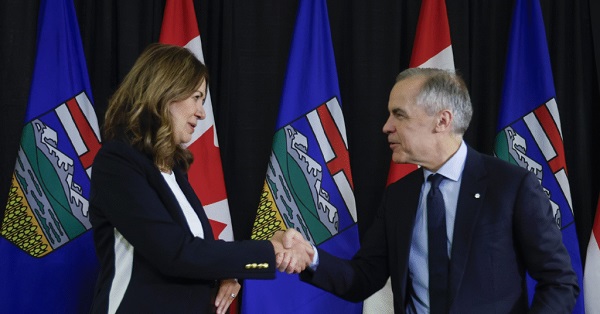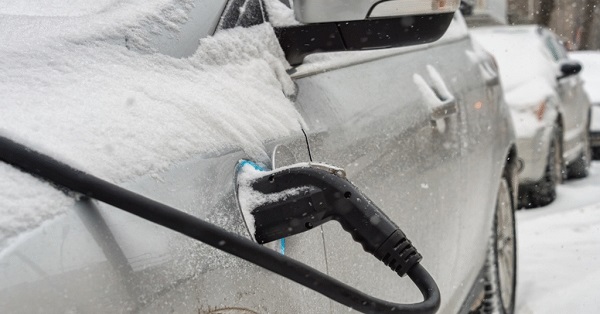Alberta
Notes from Flight 163, the oilsands shuttle from Toronto to Edmonton

Shared with permission from author Stewart Muir
Stewart Muir is a Victoria-based writer who serves as executive director of the Resource Works Society.
On a recent Monday morning, I found myself on Air Canada Flight 163 from Toronto Pearson to Edmonton. As the plane loaded, I began to sense there was something not so regular about the passengers boarding the Airbus 320 for a regularly scheduled flight.
Unlike those I more typically see on my flights, nobody was in flip-flops or golf wear, or fussing with oversized or unnecessary luggage. This was a mix mostly without the easy-to-spot snowbirds, students, and first-time fliers.
The travellers this day were mostly middle-aged men, fit-looking and dressed Mark’s Work Wearhouse casual. There were some women too, and like the men they moved with familiar ease through the cabin lugging full but neatly packed backpacks or duffels. Many carried a preferred travel distraction in hand, ready for a few hours of Netflix or sudoku. I could hear the distinctive accents of the Maritimes and Quebec, and the more familiar central Canadian English, as they found their places the way transit riders enter a subway car.
It was rapidly apparent that I was witnessing a commuter routine, one not meaningfully different than the suit-filled shuttles carrying day-tripping lawyers, accountants, pharma reps, engineers and lobbyists from the same airport that morning to destinations like Ottawa, Montreal, Boston and New York.
In concentrated form, I was witnessing a typical, daily migration of the Canadian oil sands workforce, probably with some LNG and mining thrown in. They were heading to the workplace. Not for a day, but for stretches of a week or two.
Multiply this by dozens or scores, in airports across the country, usually less starkly evident than on this particular flight, and it was just a regular day in Canadian air travel as the massive energy employee base changed shift.
A few hours later, after we unloaded at the other end, I headed for the exit and my Uber. Not so most of my fellow passengers. They continued on their way to connecting flights – to destinations such as Fort McMurray, Grande Prairie, and air services flying direct to some of the big oil sands projects – in time for shift change at the work camps where they were expected.
Statistics could not convey more forcefully than this how the oil & gas economy has a singular and powerful effect on the economy. The large paycheques drawing these men and women to their jobs in the West flowed directly back to their family bank accounts in the GTA and beyond, paying mortgages, grocery bills, taxes and hockey fees.
Flight 163, multiplied many times over, represents what the energy sector, at its most direct and tangible, does for the Canadian economy.
This is what I’m thinking about while surveying a nation that is now deep into an unprecedented social and economic crisis.
Over the coming days and weeks, things that we do will affect how deep and damaging this crisis becomes.
We are seeing Green New Deal advocates pursue the thesis that the coming economic catastrophe is the perfect moment to “transition off fossil fuels”. There are plenty of signs of this thought process – “Hey guess what guys, in one stroke we could meet the Paris Agreement by dropping emissions to 30 per cent below 2005 levels – not by 2030, but by 2021!”
To put this in perspective, consider that the Conference Board of Canada recently estimated that in one of the milder transition scenarios, meeting such targets will cost Canadians $2.2 trillion and require 14 per less use of residential energy, 47 per cent less car travel, eight times the subway use, and 54 per cent less domestic air travel.
Who’s ready to make this change overnight? We couldn’t do it if we wanted to. Think for just a moment about the costs and tradeoffs required, and the difficulty of accomplishing it in the midst of a global health crisis. Clearly it makes no sense at all. Yet Canada might be the only oil-exporting country where accelerating the transition is likely to receive serious acknowledgment in senior decision-making circles.
Even without such measures, Canada is already moving in the right direction: we are a global leader in clean energy, with 80 per cent of the population living in provinces where more than 90 per cent of electricity is drawn from non-fossil fuel sources. This alone makes us the envy of the world. The prevalence of clean electricity means that wherever it is used in industry, the resulting resource commodity exports can outcompete most other similar products in climate terms, with the bonus that they can allow importing countries to reduce their own emissions.
Mere inattention could do as much damage at this time as a wrong decision. Standing back and watching the domestic oil and gas industry topple will have an effect on citizen wellbeing far in excess of what the collapse of any other industry would bring.
We would be looking at the long-term impairment of Canadian living standards – that is to say a reduction in the value of our jobs, in our quality of life, in our educational opportunities, and in our ability to help other countries while continuing as a net positive influence on the world.
The fossil fuel industry – “it is how we earn our living”
It’s hard to describe how important the energy industry is to Canada. Let me try.
Andy Calitz, the former CEO of LNG Canada who performed the herculean task of achieving a positive final investment decision (FID) for the project before moving on to his next challenge, provided a memorable image when he spoke at a small dinner of diplomats and academics I attended not long after the FID.
When the first shipload of liquefied natural gas departs from Kitimat in a few years’ time, he said, that cargo would be worth $100 million – a staggering sum. (I’ve run this figure past a couple of experienced heads in the energy field, and nobody has scoffed at it.)
In Vancouver, we go giddy each spring at the thought of cruise ship season, which last year saw 290 sailings out of the port. If, as is commonly said, one of those sailings means $1 million injected into the local economy, how does that compare with LNG?
Back of envelope math says that a single year of LNG Canada operations, with its promised traffic of one ship in and one ship out every day, will have the impact of one century of the Vancouver cruise industry. I’m not knocking the cruise industry, it’s important and we need it. But let that comparison sink in.
Here’s another one.
Back in 2017, I calculated that natural gas investments in British Columbia that year were on a scale that equated to building the behemoth Wynn hotel in Las Vegas (4,750 rooms over 215 acres) in the Vancouver area, along with a special SkyTrain extension to serve it. ( Natural gas is back: British Columbia drilling surge is behind $5+ billion in 2017 investment )
Never mind that no investor has ever come forward with such a bold plan for a new resort anywhere in Canada. And it’s actually pretty fortunate that we got the energy infrastructure rather than the casino, given the prospects for tourism in 2020.
Economist Patricia Mohr recently pointed out that Canada is “a trading nation and an ‘energy specialist’ — it is how we earn our living.” Crude oil, all by itself, generated net exports of $62 billion in 2019, up from $57.5 billion in 2018 — far above any other export category.
As Ms. Mohr stated, oil exports come in handy given that we habitually run large deficits in other areas including motor vehicles and parts, machinery, electronic equipment, and consumer goods.
During the COVID-19 crisis, it’s obvious we cannot go without lifesaving medical necessities. Unlike our abundant oil, producing them isn’t a great strength. Canada must import billions’ worth of these goods every year. If you isolate just three medical categories – vaccines, medical apparatus and breathing aids – the numbers show clearly that our own ability to manufacture these items is very limited, even as consumption grows year after year.

The current global crisis has already brought a plummeting Canadian dollar, which in turn makes the imported goods that we rely on more costly. Exports that we can sell for U.S. dollars will offset this, but only if we have products to sell and markets ready to buy them. We need to preserve the ability to produce more as more income is needed, while at the same time figuring in the unfortunate reality that many of the things we export are themselves falling in price, so that higher production volumes are required just to stay in place.
The resource economy actually turns out – despite its detractors – to be both flexible and durable as a source of national well-being. Markets for some of the commodities we produce can be expanded at will, something that cannot be said of iPhones, beach umbrellas or BMWs.
Right now in Russia, the government is starting to realize it might not have been such a good idea to enter into an oil price war with Saudi Arabia. More and more evidence suggests that for a winner to emerge will require not months but years of effort, and at the end of it the United States oil industry, resented deeply by both Russia and Saudi Arabia, could well come on top anyways.
The most chilling observation, as reported today by the Wall Street Journal, comes from Igor Sechin, head of Russia’s largest oil producer, state-controlled giant Rosneft: “If you give up your market share, you will never get it back.”
There’s a lesson in this for Canada. Those who see an “opportunity” to deliberately give up our oil market share, to encourage a fast pivot into an unknown energy future, are playing recklessly with how we as a country earn our living. If we ratchet down production by letting industry fail, and decide later that it was a mistake to do so, we will not easily be able to retrieve our market share. That’s a frightening thought. Worse still, killing off the industry will make Canadians more dependent on imported oil, which will have to be paid for using a weakened loonie.
Doing what’s necessary
In 2018, the federal government announced an export diversification strategy that would increase Canada’s overseas exports by 50 per cent by 2025. Even before the combined oil/pandemic crisis, it seemed an unlikely ambition.
“Investing in infrastructure to support trade” was one of the ways Ottawa deemed it could aid this ambitious goal, and credit is due for supporting projects such as the so-far-incomplete Trans Mountain and Coastal GasLink pipelines.
Other forces are holding us back. The Canada Infrastructure Bank, for example, is forbidden from investing its $35 billion of capital in fossil fuel projects, even if those investments could lead to lower energy use and emissions in the oil & gas upstream.
Meanwhile, our national infrastructure minister seems physically incapable of uttering the phrase “energy infrastructure” let alone the p-word (pipelines). Even our minister of natural resources has been placed in the uncomfortable position of carrying out a mandate letter requiring him to making finding alternative employment for oil and gas workers and communities a central task.
Now is the time to save, not strangle, an oil and gas industry that is frantically signalling the need for intervention .
Prime Minister Justin Trudeau’s Quebec lieutenant Pablo Rodriguez yesterday promised Bombardier : “Our government is taking the necessary steps to get you financial help as quickly as possible.” A stock analyst opined that the Canadian and Quebec governments were “likely to offer support if Bombardier gets close to the edge.” (See Globe and Mail story .)
If a single company controlled by a wealthy clan, making luxury jets for billionaires, is to be given this treatment, then there should be no hesitation all in backing the industry that convincingly represents the foundational strength of our entire nation.
Trudeau has always found it difficult to make strong gestures of support to the Canadian oil patch. This time, finding it within himself to say those words of support matters more than ever. There is a very serious risk that Canada’s long term prosperity in both an absolute and a relative sense will be impaired by what occurs in the coming hours, days and weeks. Ahead of us, economic success will only come through determination and political commitment to put people and jobs first.
Stewart Muir is a Victoria-based writer who serves as executive director of the Resource Works Society.
Grow your business with the Daily Oil Bulletin – the trusted source for Canada’s oilpatch.
Canada in talks with the U.S. to avoid troops at the border, says Trudeau
Alberta Energy Regulator names senior Saskatchewan government official as CEO
Alberta
Alberta Next Panel calls to reform how Canada works

From the Fraser Institute
By Tegan Hill
The Alberta Next Panel, tasked with advising the Smith government on how the province can better protect its interests and defend its economy, has officially released its report. Two of its key recommendations—to hold a referendum on Alberta leaving the Canada Pension Plan, and to create a commission to review programs like equalization—could lead to meaningful changes to Canada’s system of fiscal federalism (i.e. the financial relationship between Ottawa and the provinces).
The panel stemmed from a growing sense of unfairness in Alberta. From 2007 to 2022, Albertans’ net contribution to federal finances (total federal taxes paid by Albertans minus federal money spent or transferred to Albertans) was $244.6 billion—more than five times the net contribution from British Columbians or Ontarians (the only other two net contributors). This money from Albertans helps keep taxes lower and fund government services in other provinces. Yet Ottawa continues to impose federal regulations, which disproportionately and negatively impact Alberta’s energy industry.
Albertans were growing tired of this unbalanced relationship. According to a poll by the Angus Reid Institute, nearly half of Albertans believe they get a “raw deal”—that is, they give more than they get—being part of Canada. The Alberta Next Panel survey found that 59 per cent of Albertans believe the federal transfer and equalization system is unfair to Alberta. And a ThinkHQ survey found that more than seven in 10 Albertans feel that federal policies over the past several years hurt their quality of life.
As part of an effort to increase provincial autonomy, amid these frustrations, the panel recommends the Alberta government hold a referendum on leaving the Canada Pension Plan (CPP) and establishing its own provincial pension plan.
Albertans typically have higher average incomes and a younger population than the rest of the country, which means they could pay a lower contribution rate under a provincial pension plan while receiving the same level of benefits as the CPP. (These demographic and economic factors are also why Albertans currently make such a large net contribution to the CPP).
The savings from paying a lower contribution rate could result in materially higher income during retirement for Albertans if they’re invested in a private account. One report found that if a typical Albertan invested the savings from paying a lower contribution rate to a provincial pension plan, they could benefit from $189,773 (pre-tax) in additional retirement income.
Clearly, Albertans could see a financial benefit from leaving the CPP, but there are many factors to consider. The government plans to present a detailed report including how the funds would be managed, contribution rates, and implementation plan prior to a referendum.
Then there’s equalization—a program fraught with flaws. The goal of equalization is to ensure provinces can provide reasonably comparable public services at reasonably comparable tax rates. Ottawa collects taxes from Canadians across the country and then redistributes that money to “have not” provinces. In 2026/27, equalization payments is expected to total $27.2 billion with all provinces except Alberta, British Columbia and Saskatchewan receiving payments.
Reasonable people can disagree on whether or not they support the principle of the program, but again, it has major flaws that just don’t make sense. Consider the fixed growth rate rule, which mandates that total equalization payments grow each year even when the income differences between recipient and non-recipient provinces narrows. That means Albertans continue paying for a growing program, even when such growth isn’t required to meet the program’s stated objective. The panel recommends that Alberta take a leading role in working with other provinces and the federal government to reform equalization and set up a new Canada Fiscal Commission to review fiscal federalism more broadly.
The Alberta Next Panel is calling for changes to fiscal federalism. Reforms to equalization are clearly needed—and it’s worth exploring the potential of an Alberta pension plan. Indeed, both of these changes could deliver benefits.
Alberta
Alberta’s new diagnostic policy appears to meet standard for Canada Health Act compliance

From the Fraser Institute
By Nadeem Esmail, Mackenzie Moir and Lauren Asaad
In October, Alberta’s provincial government announced forthcoming legislative changes that will allow patients to pay out-of-pocket for any diagnostic test they want, and without a physician referral. The policy, according to the Smith government, is designed to help improve the availability of preventative care and increase testing capacity by attracting additional private sector investment in diagnostic technology and facilities.
Unsurprisingly, the policy has attracted Ottawa’s attention, with discussions now taking place around the details of the proposed changes and whether this proposal is deemed to be in line with the Canada Health Act (CHA) and the federal government’s interpretations. A determination that it is not, will have both political consequences by being labeled “non-compliant” and financial consequences for the province through reductions to its Canada Health Transfer (CHT) in coming years.
This raises an interesting question: While the ultimate decision rests with Ottawa, does the Smith government’s new policy comply with the literal text of the CHA and the revised rules released in written federal interpretations?
According to the CHA, when a patient pays out of pocket for a medically necessary and insured physician or hospital (including diagnostic procedures) service, the federal health minister shall reduce the CHT on a dollar-for-dollar basis matching the amount charged to patients. In 2018, Ottawa introduced the Diagnostic Services Policy (DSP), which clarified that the insured status of a diagnostic service does not change when it’s offered inside a private clinic as opposed to a hospital. As a result, any levying of patient charges for medically necessary diagnostic tests are considered a violation of the CHA.
Ottawa has been no slouch in wielding this new policy, deducting some $76.5 million from transfers to seven provinces in 2023 and another $72.4 million in 2024. Deductions for Alberta, based on Health Canada’s estimates of patient charges, totaled some $34 million over those two years.
Alberta has been paid back some of those dollars under the new Reimbursement Program introduced in 2018, which created a pathway for provinces to be paid back some or all of the transfers previously withheld on a dollar-for-dollar basis by Ottawa for CHA infractions. The Reimbursement Program requires provinces to resolve the circumstances which led to patient charges for medically necessary services, including filing a Reimbursement Action Plan for doing so developed in concert with Health Canada. In total, Alberta was reimbursed $20.5 million after Health Canada determined the provincial government had “successfully” implemented elements of its approved plan.
Perhaps in response to the risk of further deductions, or taking a lesson from the Reimbursement Action Plan accepted by Health Canada, the province has gone out of its way to make clear that these new privately funded scans will be self-referred, that any patient paying for tests privately will be reimbursed if that test reveals a serious or life-threatening condition, and that physician referred tests will continue to be provided within the public system and be given priority in both public and private facilities.
Indeed, the provincial government has stated they do not expect to lose additional federal health care transfers under this new policy, based on their success in arguing back previous deductions.
This is where language matters: Health Canada in their latest CHA annual report specifically states the “medical necessity” of any diagnostic test is “determined when a patient receives a referral or requisition from a medical practitioner.” According to the logic of Ottawa’s own stated policy, an unreferred test should, in theory, be no longer considered one that is medically necessary or needs to be insured and thus could be paid for privately.
It would appear then that allowing private purchase of services not referred by physicians does pass the written standard for CHA compliance, including compliance with the latest federal interpretation for diagnostic services.
But of course, there is no actual certainty here. The federal government of the day maintains sole and final authority for interpretation of the CHA and is free to revise and adjust interpretations at any time it sees fit in response to provincial health policy innovations. So while the letter of the CHA appears to have been met, there is still a very real possibility that Alberta will be found to have violated the Act and its interpretations regardless.
In the end, no one really knows with any certainty if a policy change will be deemed by Ottawa to run afoul of the CHA. On the one hand, the provincial government seems to have set the rules around private purchase deliberately and narrowly to avoid a clear violation of federal requirements as they are currently written. On the other hand, Health Canada’s attention has been aroused and they are now “engaging” with officials from Alberta to “better understand” the new policy, leaving open the possibility that the rules of the game may change once again. And even then, a decision that the policy is permissible today is not permanent and can be reversed by the federal government tomorrow if its interpretive whims shift again.
The sad reality of the provincial-federal health-care relationship in Canada is that it has no fixed rules. Indeed, it may be pointless to ask whether a policy will be CHA compliant before Ottawa decides whether or not it is. But it can be said, at least for now, that the Smith government’s new privately paid diagnostic testing policy appears to have met the currently written standard for CHA compliance.

Lauren Asaad
Policy Analyst, Fraser Institute
-

 International1 day ago
International1 day agoAustralian PM booed at Bondi vigil as crowd screams “shame!”
-

 Health2 days ago
Health2 days agoFDA warns ‘breast binder’ manufacturers to stop marketing to gender-confused girls
-

 Daily Caller2 days ago
Daily Caller2 days agoTrump Reportedly Escalates Pressure On Venezuela With Another Oil Tanker Seizure
-

 Business2 days ago
Business2 days agoThere’s No Bias at CBC News, You Say? Well, OK…
-

 Uncategorized1 day ago
Uncategorized1 day agoMortgaging Canada’s energy future — the hidden costs of the Carney-Smith pipeline deal
-

 Opinion1 day ago
Opinion1 day agoReligion on trial: what could happen if Canada passes its new hate speech legislation
-

 International2 days ago
International2 days ago2025: The Year The Narrative Changed
-

 Automotive14 hours ago
Automotive14 hours agoCanada’s EV gamble is starting to backfire





